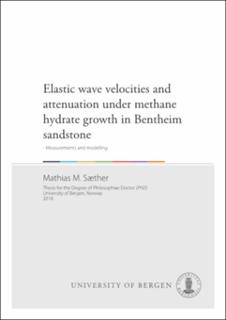| dc.description.abstract | Due to the potential for using methane hydrates as an energy source, localizing, monitoring and describing hydrate deposit areas are of interest. This has previously been attempted by using acoustic methods and thus information on the relation between the hydrate saturation, SH, and acoustic properties, such as cP , cS (compressional and shear wave velocity, respectively) and P (compressional wave attenuation coe scient) is needed. The overall aim of this PhD thesis is to measure and discuss cP , cS and the change in P ( P ) in ten Bentheim sandstone specimen having di erent initial water saturations, Sw0 as a function of SH, during hydrate growth. In the literature, laboratory studies typically focus on measuring cP and cS in unconsolidated hydrate bearing sediments using the " rst arrival of the pulse," which means that the measurement frequency of the elastic wave is not de ned. Only a few laboratory studies are found by this author to measure acoustic properties for hydrate bearing sediments for de ned frequencies, and only one study is found to report P during hydrate growth. Although one study is found on hydrate bearing consolidated sediments, no laboratory studies are found by this author to measure cP , cS and the change in P for Bentheim sandstone during hydrate growth. In this work, a pressure cell in which hydrates may grow is modi ed so that acoustic measurements can be conducted during hydrate growth. Piezoelectric shear-wave (Swave) and compressional wave (P-wave) transducers are designed and constructed to be used with the solid bu er measurement method and to t inside the pressure cell. Due to the limited space inside the pressure cell, unwanted acoustic re ections from e.g. sidewalls will a ect the measurements. The S-wave transducers transmit both P-waves and S-waves and mode conversion between these may also occur. To measure P-wave or S-waves, short pulses are needed to separate the measurement signal from the other re ected or mode converted signals. To do so, broadbanded transducers are designed with tungsten-epoxy backing and a quarter wave-length front-layer. The Fourier spectrum method is able to determine the frequency content of the short measured signals and is thus used as the main signal processing method together with the solid bu er method for both the S-wave transducers and the P-wave transducers. The e ect of the unwanted side-wall re ections and di raction e ects are investigated using nite element simulations on plexiglas specimen having approximately the same dimensions as the Bentheim sandstone specimen. The Fourier spectrum method is simulated using the nite element simulations together with Fourier synthesis. cP , cS and P for plexiglas measured with the solid bu er method are compared with measurements conducted with the immersion measurement method. The deviation found between these measurement methods aid in understanding the importance of determining the e ects of sound di raction and unwanted sidewall re ections. Four main categories of measurement results are presented: 1) how the absolute cP and cS, and the relative values of cP , cS and P , change with SH, 2) how the cP =cS ratio changes with SH, 3) how the compressional wave absorption spectrum di ers between distinct SH, and 4) investigate if dispersion of acoustic waves can be detected. Hydrates can grow inside a sandstone in di erent ways, a ecting the acoustic properties di erently. The distribution of water and gas inside the sandstone also a ect the acoustic properties. To investigate the relation between cP , cS, Sw0 and SH, the results are compared with several numerical hydrate growth models. In the rst model, hydrates only form in the uid, thus " oating" around in the pores. In the second model hydrates grow into the sandstone, becoming a part of the dry frame, acting as second type of load-bearing sediment grain. In the third model, hydrates act as cement around grain contacts, thus sti ening the dry frame. To investigate how the change in P may be related to SH, two more models are used. The rst attenuation model is based on modeling the Biot ow and squirting ow inside the sandstone during hydrate growth. These are attenuation mechanisms caused by pressure induced uid ow. The second attenuation model is based on Waterman and Truell's multiple scattering theory. As the attenuation mechanisms inside a sandstone is very complex, no attempt is done to directly relate P , Sw0 and SH. However, based on the numerical attenuation models, it is indicated whether pressure induced uid ow and multiple scattering mechanisms are present in hydrate bearing Bentheim sandstones. | en_US |
